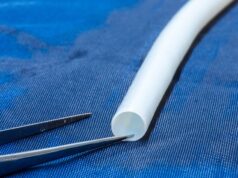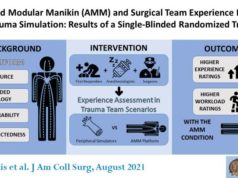
Use of incisional negative pressure wound therapy (NPWT) does not change the rate of deep surgical site infection, for patients undergoing surgery for major trauma-related lower limb fractures, according to results of the WHIST randomised clinical trial. Published online in the Journal of the American Medical Association (JAMA), no significant difference was found when comparing patients treated with NPWT and a standard dressing.
Matthew L Costa (University of Oxford, Oxford, UK) and colleagues write that the findings of the trial, which included 1,548 adults, “do not support the use of incisional NPWT for surgical wounds associated with lower-limb fractures from major trauma”, although they note that “the event rate at 30 days was lower than expected”.
According to the authors of WHIST, deep wound infection rates are “high” following surgeries on major trauma-related fractures. “Treating these fractures is complicated by the systematic inflammatory response to major trauma, as well as the extensive soft tissue injuries adjacent to the broken bone which, taken together, may cause high rates of wound infection following surgery for lower-limb fractures after major trauma,” Costa et al explain.
There has been some suggestion that new techniques for wound management, such as incisional NPWT, have potential for reducing the rate of infection, though the evidence for this profile of surgical patients is limited. “The aim of this randomised clinical trial,” write the authors, “was to determine if incisional negative pressure wound therapy was more effective than standard wound dressing in reducing the rate of deep surgical site infection in wounds associated with surgery for a fracture in the context of major trauma to the lower limb.”
The trial was conducted at 24 trauma hospitals in the UK between July 2016 and April 2018, with all of the 1,548 adults who participated in the study over the age of 16 years. Of these patients, 785 were randomised to receive incisional NPWT, while 763 received a standard wound dressing that did not involve negative pressure.
“The primary outcome measure was deep surgical site infection at 30 days, diagnosed according to the criteria from the US Centers for Disease Control and Prevention,” write Costa and colleagues. They add that a pre-planned secondary analysis of the primary outcome was performed at 90 days. Furthermore, secondary outcomes for WHIST included patient-reported disability, health-related quality of life, surgical scar assessment and chronic pain at three and six months, as well as other local wound healing complications at 30 days.
Of the 1,548 participants (mean age, 49.8 years; 38% women [n=583]) who were randomised, Costa et al report that 1,519 (98%) had data available for the primary outcome. “At 30 days, deep surgical site infection occurred in 5.8% (45 out of 770 patients) of the incisional negative pressure wound therapy group, and in 6.7% (50 out of 749 patients) of the standard wound dressing group (odds ratio, 0.87 [95% CI, 0.57–1.33]; absolute risk difference, -0.77% [95% CI, -3.19–1.66%]; P=0.52)” they explain.
Additionally, there was no significant difference in the deep surgical site infection rate at 90 days; 11.4% (72 out of 629 patients) in the NPWT group developed an infection, compared to 13.2% (78 of 590 patients) in the standard dressing group (odds ratio, 0.84 [95% CI, 0.59–1.19]; absolute risk difference, -1.76% [95% CI, -5.41–1.90%]; P=0.32). “For the five prespecified secondary outcomes reported, there were no significant differences at any time point,” continue the authors.
Highlighting some of the trial’s limitations, Costa et al comment: “First, because of the emergency nature of the surgery, it was anticipated that some patients who were randomised would subsequently be unable or unwilling to participate. However, the majority of patients (85%) agreed to participate. Second, 100 patients did not receive the randomised intervention. As expected, when testing a relatively new intervention such as incisional NPWT, the majority of the crossovers were from the incisional negative pressure wound therapy group to the standard wound dressing group (n = 92).”
Concluding, the authors state: “Among patients who underwent surgery for major trauma-related lower limb fractures, use of incisional negative pressure wound therapy, compared with standard wound dressing, resulted in no significant difference in the rate of deep surgical site infection. The findings do not support the use of incisional negative pressure wound therapy in this setting, although the event rate at 30 days was lower than expected.”













